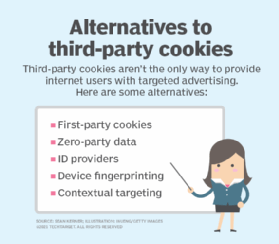
Getty Images
Tracking pixel vs. cookie: What's the difference?
While tracking pixels and cookies accomplish similar tasks, they work in different ways. Here's how.
Tracking pixels and cookies have long been used in digital marketing to track consumer behavior. The data they collect lets companies deliver targeted ads to consumers. They also help to provide a more personalized and efficient web browsing experience for users.
But these covert tracking pixels and third-party cookies have fueled concerns about invasive marketing and data privacy. In 2023, the Federal Trade Commission took action against GoodRx and BetterHelp over concerns that sensitive user health information was being shared with third-party marketers.
Data protection regulations affect the use of tracking pixels and cookies, but regulations vary depending on location. The European Union adopted the General Data Protection Regulation (GDPR) in 2016. The United States has yet to enact a federal data protection regulation of its own. Individual states across the U.S. have adopted privacy laws and regulations, with California leading the way in 2018 with the California Consumer Privacy Act (CCPA). But this lack of regulation has led consumers to develop their own data protection measures.
In January 2024, Google Chrome rolled out the testing phase of its Tracking Protection feature to 1% of Chrome users globally. This feature blocks third-party cookies for Chrome users, limiting tracking across different websites. This will not affect first-party cookies, and users can choose to re-enable third-party cookies as needed. Google has again delayed plans to phase out third-party cookies in Chrome. It is now expected to happen in 2025. Both Apple Safari and Mozilla Firefox introduced privacy features to prevent cross-site tracking ahead of Google.
With the final stages of phasing out third-party cookies approaching, companies will have to adjust their digital marketing strategies. Pixels and cookies have pros and cons from both a user and marketing standpoint. Here are ways that the two differ.
What is a tracking pixel?
A tracking pixel is a tiny, transparent pixel embedded into the HTML code of a website, email or ad. These typically take the form of a 1x1 pixel that blends in with the background of the page on which it appears and is not easily detected by users.
Also known as marketing pixels, they collect data about users, such as what webpages they visit and what ads they click on. Tracking pixels are used for simple tasks like letting users know their email has been read or more complex tasks such as gathering marketing data for companies.
The following are the two main types of tracking pixels:
- Retargeting pixels. Retargeting is an online marketing tactic in which companies aim to reengage users after they leave their site. Retargeting pixels track the user's behavior and use that information to deliver targeted ads on other websites. This works to draw users back to the original site or purchase.
- Conversion pixels. These pixels track the effectiveness of marketing campaigns and funnels. They can track conversions, such as registering on a site or making a purchase. Conversion pixels let companies see how customers find them to make a purchase, whether through an ad, an affiliate link or another route.
What is a cookie?
Cookies are small pieces of unique data, typically stored in text files. Also known as HTTP cookies or internet cookies, they identify unique users by storing this data on the user's computer. This lets websites personalize user experiences.

Cookie data often includes a site name and a unique identifier. They can also contain personal user information such as name, address, email or phone number. Cookies are created by the network's server and are stored on users' browsers once they visit the site and accept the cookie terms.
When the server reads the cookie data stored in a user's web browser, it can identify the user. Cookies let websites store user login information so they don't have to log in each time they visit. Cookies are responsible for remembering shopping cart items and auto-filling information into forms. And like tracking pixels, they can track users' interaction with ads, track items they have viewed and enable targeted ads.
The following are the four main types of cookies:
- First-party cookies. These cookies are created by the website a user is visiting. They store relevant information, such as settings preferences and viewing history. These cookies improve user experience and are safe as long as the website is reputable and free of recent data breaches.
- Third-party cookies. These cookies track user behavior for advertising purposes and are not directly related to the website a user is browsing. They are embedded in ads, web banners, videos and certain social media interactions. Digital marketers can use third-party cookies to access user browser history on any site where their ads are placed. Zombie cookies, also known as supercookies, are a type of third-party cookie that is notoriously difficult to remove.
- Session cookies. These cookies store user data only while a user is navigating the website. This prevents the need to reauthenticate on each webpage the user visits. Once the user leaves the site, all session cookies are wiped from their web browser.
- Persistent cookies. These cookies, which track and gather information, remain on a user's computer after they leave the site. This lets websites create a profile of the user's search history to recommend relevant products or content. Persistent cookies remain on the user's computer until the expiration date, when the cookie is automatically deleted.
Differences between pixels and cookies
While tracking pixels and cookies are similar and often used together, there are some key differences.
| Tracking pixels | Cookies |
| Collect data from users and deliver it to a server. | Place data on users' browsers to later be read by the server. |
| Typically hidden on a webpage and are not meant to be seen by users. Tracking pixels should be stated in a website's privacy policy. | Websites are required to ask for permission to use cookies with a pop-up. |
| Used for marketing purposes. | Used for marketing purposes and to improve user experience. |
| Can collect personal information such as the user's operating system, IP address and location. | Can collect personal information such as the user's name, address, email and phone number. |
| Cannot be disabled by users. | Users can disable, block or clear cookies from their browsers. |
| Can follow users across devices. | Cannot follow users across devices. |
Privacy concerns
Most cookies and pixels that users encounter are harmless. While the information collected by third-party cookies and tracking pixels can provide users with a more personalized browsing experience, the concern lies with the potential for data to be sold or breached.
The data collected by tracking pixels is meant to assist digital marketers, but it can also end up in the wrong hands. When this data is compromised, spammers or hackers can gain access to personal information, and it can sometimes end up on the dark web. There are specific concerns over tracking pixels in certain industries. For example, in digital healthcare, HIPAA-protected information can be inappropriately collected and shared.
An added concern with tracking pixels is that they are not visible to users. This often allows pixels to operate without users' knowledge, which prevents them from consenting or opting out. Users should be aware that many sites operate with tracking pixels and they should have a privacy policy disclosing pixel use at the bottom of the webpage.
Companies can reduce the risk of compromising user privacy by complying with data privacy regulations such as GDPR and CCPA. They should limit the data they collect to only what is necessary for their marketing needs to prevent collecting personally identifiable information or other types of sensitive information that could be compromised.
The main concern with third-party cookies is cross-site tracking, which allows for invasive ads. Cookies are a set piece of data, making them relatively harmless. Another concern is cookie hijacking, where a cybercriminal can access personal information through a user's cookies.
Websites are now required to offer users the option to decline cookies through pop-ups. Many browsers are already blocking third-party cookies by default, and users have the option to turn off nonessential cookies.
Ava DePasquale is a freelance content writer.







